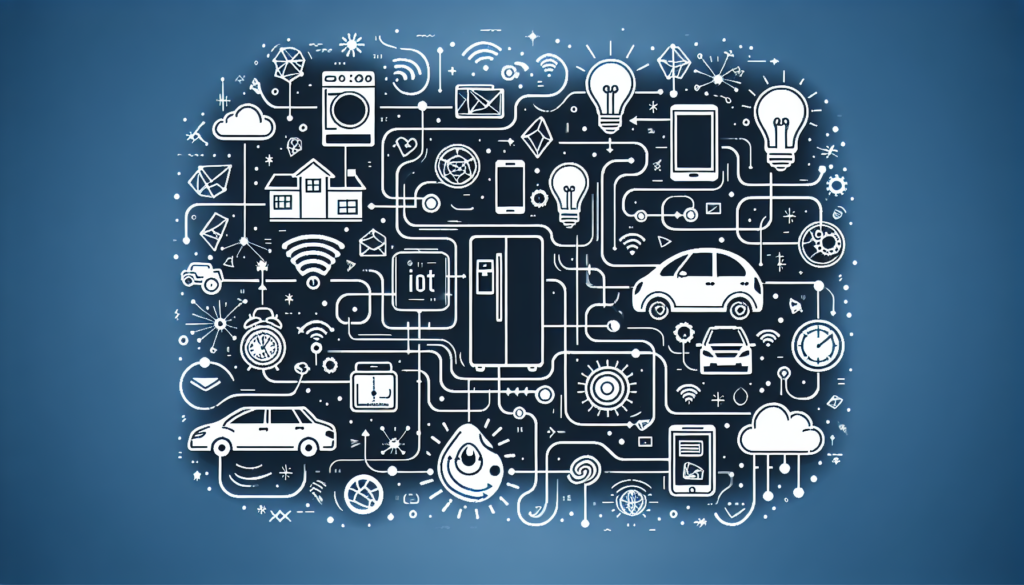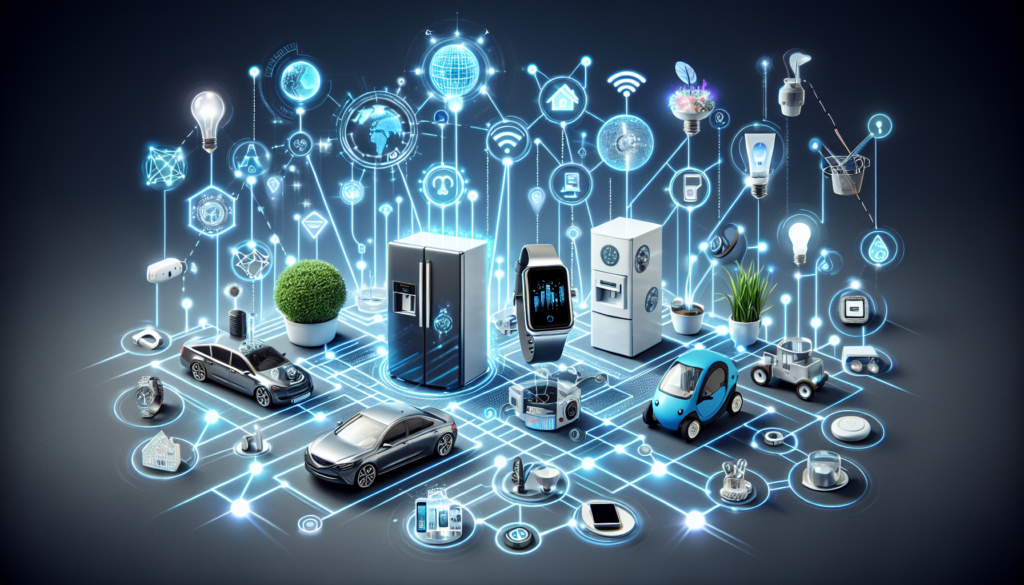Imagine a world where your refrigerator could not only keep your food fresh, but could also send you a notification when you’re running low on milk. Or picture a thermostat that adjusts the temperature in your home based on your preferences and daily routine. These are just a couple of examples of the Internet of Things, or IoT, which refers to the connection of everyday devices to the internet. In simple terms, IoT is the network of physical objects that are embedded with sensors, software, and other technologies in order to exchange data with other devices and systems. So, whether it’s a smart car, a wearable fitness tracker, or even a connected coffee machine, IoT is revolutionizing the way we live, work, and interact with the world around us.

Definition of IoT
The Internet of Things (IoT) refers to the network of physical objects, devices, and sensors that are connected and able to collect and exchange data. These objects can include everyday items such as appliances, vehicles, and even buildings. IoT enables these objects to be remotely monitored, controlled, and interacted with using the internet as a communication medium. Through the integration of sensors, connectivity, and data processing capabilities, IoT technology allows for the automation and optimization of various processes and services.
Explanation of IoT
IoT can be thought of as a vast interconnected system that brings together the physical and digital worlds. It involves the use of sensors to collect data from the real world, which is then transmitted and processed to generate actionable insights. This network of connected devices enables seamless communication and interaction between devices, as well as between devices and humans. By harnessing the power of IoT, businesses and individuals can leverage the wealth of data generated by these devices to make informed decisions, streamline operations, and enhance their overall productivity and quality of life.
Key components of IoT
The key components of IoT include:
-
Sensors and Actuators: These devices are responsible for collecting data from the physical environment and converting it into a usable digital format. Sensors can detect various parameters such as temperature, pressure, motion, and humidity, while actuators enable the control of physical devices, such as turning on/off lights or opening/closing doors.
-
Connectivity: IoT relies on a range of connectivity technologies, such as Wi-Fi, cellular networks, Bluetooth, and RFID (Radio Frequency Identification), to enable seamless communication between devices and the internet.
-
Data Processing and Analytics: The data collected by IoT devices is processed and analyzed using various techniques, such as cloud computing and edge computing. This allows for real-time monitoring, predictive analysis, and the extraction of meaningful insights from the vast amounts of data generated by IoT devices.
-
User Interfaces: IoT devices often include user interfaces that allow individuals to interact with and control them. User interfaces can be in the form of mobile apps, web interfaces, or voice-controlled assistants.
How IoT Works
Data collection
In IoT, data collection is the process of capturing information from the physical environment using sensors and other data collection devices. This data can come from a wide variety of sources, such as temperature sensors, motion detectors, GPS trackers, and more. The sensors continuously monitor their surroundings and measure specific parameters, converting them into digital signals that can be further processed and analyzed.
Communication and connectivity
Once the data is collected, IoT devices need to be able to transmit it to a central server or cloud platform for further analysis. This is achieved through various connectivity options, such as Wi-Fi, cellular networks, or even satellite communication. The data is securely transmitted over these networks, ensuring that it reaches the intended destination.
Data processing and analysis
After the data is transmitted, it is processed and analyzed using algorithms and artificial intelligence (AI) techniques. This step involves extracting valuable insights, detecting patterns, and making predictions based on the collected data. Cloud computing and edge computing play a crucial role in handling the massive amounts of data generated by IoT devices, allowing for real-time analysis and decision-making.
Examples of IoT
Smart home devices
IoT has revolutionized the way we interact with our homes. Smart home devices, such as smart thermostats, security cameras, and voice assistants, enable us to control and monitor various aspects of our homes remotely. For example, using a smartphone app, you can adjust the temperature of your home, lock and unlock doors, and even check live video feeds from your surveillance cameras from anywhere in the world.
Wearable fitness trackers
Wearable fitness trackers, such as smartwatches and fitness bands, have become increasingly popular thanks to IoT technology. These devices collect data about your physical activity, heart rate, sleep patterns, and more, and provide you with insights and recommendations to improve your health and fitness. They can also sync with your smartphone or computer to track your progress and provide personalized coaching.
Smart city technology
IoT is transforming cities into smart, interconnected ecosystems. Smart city technology includes intelligent street lighting, waste management systems, traffic management, and public transportation systems. These systems leverage IoT to monitor and optimize various aspects of urban life, resulting in reduced energy consumption, improved traffic flow, and enhanced quality of life for residents.
Benefits of IoT
Improving efficiency and productivity
IoT technology helps businesses and individuals streamline their operations and improve overall efficiency. For example, in manufacturing, IoT-enabled sensors can monitor equipment performance, detecting anomalies and predicting maintenance needs. This allows for preventive maintenance, reducing downtime and maximizing productivity. Similarly, in agriculture, IoT can optimize irrigation systems based on real-time weather data, saving water resources and increasing crop yield.
Enhancing convenience and comfort
IoT devices bring convenience and comfort to our daily lives. Smart home devices allow us to control our homes remotely, providing us with peace of mind and saving time. For instance, you can turn on the lights, adjust the thermostat, or even start the coffee machine before you arrive home. IoT also enables personalized experiences, such as customized recommendations on streaming platforms or personalized healthcare insights delivered by wearable devices.
Enabling predictive maintenance
One of the significant benefits of IoT is predictive maintenance. By continuously monitoring and analyzing data from equipment or assets, IoT can detect patterns and identify potential failures before they occur. This allows for proactive maintenance, reducing costly breakdowns and avoiding unnecessary downtime. Predictive maintenance can be applied to various industries, including manufacturing, energy, transportation, and healthcare.
Enhancing safety and security
IoT technology plays a crucial role in enhancing safety and security. In smart homes, IoT-enabled security systems can detect suspicious activities, send real-time alerts, and even notify emergency services if necessary. Similarly, in industries such as mining or construction, IoT can monitor the environment for hazardous conditions and provide warnings to workers. By leveraging IoT, organizations can create safer environments for employees and customers alike.

Challenges of IoT
Data security and privacy concerns
As IoT devices generate and transmit vast amounts of data, data security and privacy become major concerns. With more devices connected to the internet, the risk of unauthorized access or data breaches increases. Protecting sensitive information, such as personal data or proprietary business data, becomes paramount. Implementing strong security measures, such as encryption, secure authentication, and regular software updates, is crucial to mitigate these risks.
Compatibility and interoperability issues
The vast ecosystem of IoT devices often leads to compatibility and interoperability challenges. Different devices may use different communication protocols or data formats, making it difficult to seamlessly integrate them. This can hinder the interoperability between devices from different manufacturers or limit the ability to scale or customize IoT solutions. Standards and protocols need to be established to ensure seamless connectivity and interoperability across devices and platforms.
Scalability and network congestion
As the number of IoT devices continues to grow, scalability and network congestion become significant challenges. A network that can handle a few hundred devices may struggle to handle thousands or millions of devices simultaneously. This can result in delays, connection drops, and reduced overall performance. High-speed and reliable networks, such as 5G, are crucial to address these challenges and ensure the seamless operation of IoT devices on a large scale.
Future of IoT
Expansion of IoT applications
The future of IoT is projected to witness a significant expansion in its applications across various industries. From healthcare and agriculture to transportation and manufacturing, IoT is expected to drive innovation and unlock new possibilities. We can expect to see advancements in areas such as smart grid management, remote patient monitoring, autonomous vehicles, and more. As technology continues to evolve, IoT will further enhance and transform how we live and work.
Increased integration with AI and machine learning
AI and machine learning are increasingly becoming integral parts of IoT deployments. By combining IoT with AI and machine learning algorithms, IoT devices can become more intelligent and capable of making automated decisions based on data analysis. For example, AI-powered IoT systems can detect anomalies in data patterns and automatically trigger actions or alerts. This integration will further enhance the efficiency and effectiveness of IoT applications.
Emergence of 5G network
The deployment of 5G networks is set to revolutionize the IoT landscape. With its ultra-fast speeds, low latency, and high bandwidth, 5G will open up new possibilities for IoT applications. It will enable real-time communication, support a massive number of connected devices, and provide a more reliable and responsive network infrastructure. This will significantly accelerate the growth and adoption of IoT, paving the way for advanced use cases and innovations.
Innovative IoT Use Cases
Smart agriculture
IoT is transforming the agriculture industry by enabling smart farming practices. By deploying IoT sensors in fields, farmers can monitor soil moisture levels, temperature, and humidity, helping optimize irrigation and fertilization. IoT can also provide real-time weather data for better crop management. Additionally, automated machinery and drones equipped with IoT technology can perform tasks such as seeding, pesticide spraying, and crop monitoring, increasing efficiency and reducing manual labor.
Healthcare monitoring
IoT has the potential to revolutionize healthcare by enabling remote patient monitoring, personalized medicine, and improved patient outcomes. Wearable devices can continuously monitor vital signs and transmit real-time data to healthcare providers. This allows for early detection of health issues, proactive interventions, and reduced healthcare costs. IoT also facilitates the seamless exchange of patient health information between different healthcare providers, enhancing the quality and continuity of care.
Industrial automation
IoT is driving industrial automation by enabling smart factories and predictive maintenance. IoT sensors integrated into industrial machinery can monitor equipment performance, detect anomalies, and predict maintenance needs. This helps prevent costly breakdowns and maximizes productivity. IoT can also facilitate the integration of robotics and autonomous systems on the factory floor, leading to increased efficiency, improved safety, and reduced operational costs.
Retail optimization
IoT is reshaping the retail industry by enabling personalized shopping experiences, inventory optimization, and smart supply chain management. RFID tags and sensors can track inventory levels in stores, warehouses, and throughout the entire supply chain in real-time. This enables retailers to optimize stock levels, detect out-of-stock or expired items, and streamline the replenishment process. IoT also allows for personalized recommendations and targeted marketing, enhancing the overall customer experience.
Summary
In conclusion, IoT is a transformative technology that connects the physical and digital worlds, enabling the collection, communication, and analysis of data from various devices and sensors. It has applications across a wide range of industries, from smart homes and wearables to healthcare monitoring and industrial automation. IoT offers numerous benefits, such as improved efficiency, convenience, predictive maintenance, and enhanced safety. However, it also presents challenges, including data security concerns, compatibility issues, and scalability limitations. Nevertheless, the future of IoT is promising, with increased integration with AI, the emergence of 5G networks, and innovative use cases in agriculture, healthcare, industrial automation, and retail.
